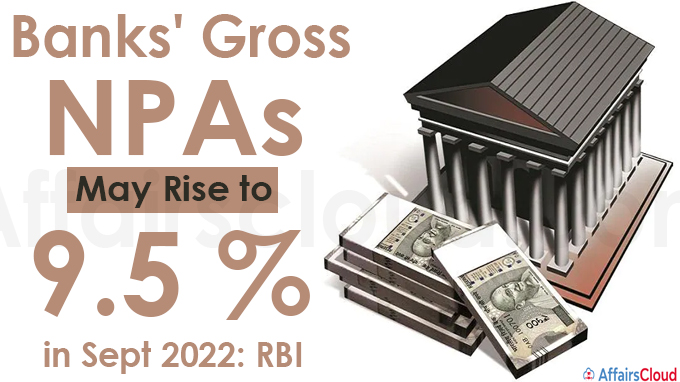
On December 29, 2021, Reserve Bank of India (RBI) released the 24th issue of its Financial Stability Report (FSR) 2021. It estimated the Scheduled Commercial Banks (SCBs) Gross Non-Performing Assets (GNPAs) to rise from 6.9 percent in September 2021 to 8.1 percent of total assets by September 2022 (under a baseline scenario) and to 9.5 percent (under severe stress scenario).
What is FSR?
It is the bi-annual collective assessment of the Sub-Committee of the ‘Financial Stability and Development Council’ (FSDC-SC) on risks to financial stability.
Financial Stability Report Key Projections:
i.SCBs’ GNPA and NNPA Ratio Projection at end-September 2021:
| Type | GNPA Ratio | Net Non-Performing Assets (NNPA) Ratio |
|---|---|---|
| All SCBs | 6.9% | 2.3% |
| Public Sector Banks (PSBs) | 8.8% | 3.0% |
| Private Banks (PVBs) | 4.6% | 1.3% |
| Foreign Banks (FBs) | 3.2% | 0.6% |
- The PSBs’ GNPA ratio of 8.8 percent in September 2021 may decline to 10.5 percent by September 2022 (under the baseline scenario) and for PSBs, it may rise from 4.6 percent to 5.2 percent.
- GNPAs of SCBs stood at 7.5 percent in March 2021.
ii.Capital to Risk-weighted Assets Ratio (CRAR):
- The capital to risk-weighted assets ratio (CRAR) of SCBs increased to a new peak of 16.6 percent and their provisioning coverage ratio (PCR) stood at 68.1 percent in September 2021.
- The system-level Tier-I leverage ratio stood at 7.5 percent in September 2021.
Note – PCR is the percentage of bad assets that the bank has to provide for from their own funds.
iii.CET-1:The common equity Tier I (CET 1) capital ratio of SCBs is expected to reach 12.5 percent by September 2022 (under the baseline scenario).
iv.Credit Growth:
- Aggregate deposits growth (year-on-year(y-o-y)) moderated from end-March 2021 to touch 9.3 percent by December 3, 2021.
- Credit growth of All SCBs, PSBs, PVBs and FBs in end-September 2021 stood at 6.7 percent, 3.5 percent, 10.8 percent, and 16.0 percent (y-o-y) respectively.
- Aggregate credit extended by NBFCs at the end of September 2021 stood at Rs 27.4 lakh crore.
v.Provider and Borrower:
- AMC-MFs (Asset Management Companies – Mutual Funds) maintained their position as the largest network provider of funds to the financial system as of end-September 2021. Insurance companies were the second largest net providers of funds to the financial system.
- NBFCs were the largest net borrowers of funds from the financial system HFCs (Housing Finance Companies) were the second-largest net borrowers of funds
Other Points to be noted:
i.Global trade volume is projected to grow by 9.7 percent in 2021 and by 6.7 percent in 2022
ii.The International Monetary Fund (IMF) revised its outlook for the global economy and it expected the global output to grow by 5.9 percent in 2021 before moderating to 4.9 percent in 2022.
iii.The Indian economy expanded by 8.4 percent year-on-year (y-o-y) in July-September 2021.
iv.FDI (Foreign Direct Investment) inflows amounted to US$ 30.5 billion in H1:2021-22 up from US$ 29.2 billion in H1:2020-21.
Recent Related News:
The Working Group (WG) on Digital Lending including Lending through Online Platforms and Mobile Apps, which was constituted by the Reserve Bank of India (RBI), has submitted its report in November 2021.
About Reserve Bank of India(RBI):
Establishment – 1st April 1935
Headquarters – Mumbai, Maharashtra
Governor – Shaktikanta Das
Deputy Governors – Mahesh Kumar Jain, Michael Debabrata Patra, M. Rajeshwar Rao, T. Rabi Sankar




